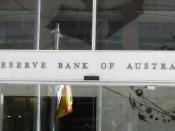The Reserve Bank of Australia (RBA) is responsible over Australia's monetary policy, which includes responsibility over inflation, interest rates, employment and the overall stability and growth of the economy. Its other responsibilities include the issuing of bank notes, and the overseeing of the payments system. Established by the Reserve Bank Act of 1959, its main tool for controlling the economy is the changing of short-term interest rates. It operates independently from the government, however it is still accountable to them.
The RBA's major responsibility is monetary policy, especially in the areas of exchange rate, inflation, interest rate and employment. It states in Section 10(2) of the Reserve Bank Act that the bank will ensure that monetary policy is directed at helping to maintain:
(a) the stability of the currency of Australia;
(b) full employment in Australia; and
(c) the economic prosperity and welfare of the people of Australia.
The Reserve Bank of Australia controls monetary policy through the short-term interest rate, or cash rate (see right).
The cash rate varies from day to day, and reflects the amount of funds available to the commercial banks, and the interest charged on those funds.
The RBA uses the cash rate to directly control the interest rates provided on loans, and returned on savings. This interest rate is changed, and can changed patterns of spending and borrowing. The RBA has often used it to control the level of credit card debt, or to slow down a housing boom.
The RBA can also exercise control, to a certain extent, on the inflation rate. It does this with the effect of the cash rate on demand, by slowing demand, the inflation rate is reduced, and by increasing demand, the inflation rate is increased. The RBA has a target of 2% - 3% for inflation...


